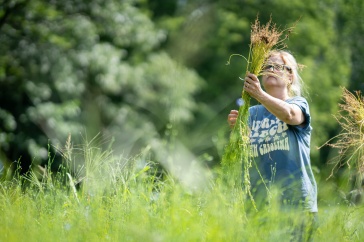
New research from the University of New Hampshire finds that unlike most insects, burying beetles provide parental care to their offspring.
Before having a baby, most human parents plan and prepare to make sure they can provide for their new bundle of joy. They determine if they are able to feed them, give them a good home and provide them with the best chance to grow up. Researchers at the University of New Hampshire have found a similar behavioral pattern in the beetle world — specifically with burying beetles, who may plan reproduction based on the availability of resources such as food.
“What we see here is burying beetles providing parental care, which the majority of insects do not,” says Brooke Woelber, a doctoral candidate in the biological sciences department and the study’s lead author. “They are assessing their situation and making decisions about the number of offspring they should have, and how many could survive, in certain environments.”
In the study, recently published in the Journal of Ethology, the researchers manipulated different environments by increasing or decreasing the number of beetles, which either increased or decreased the competition for food and changed the availability of food for future offspring. This was done to see if it would influence the decisions made by the breeding pair, or prospective parents, about the size of their family.
“Burying beetles are one of the few insects where both the male and female parent provide care to their developing young — much like what we see in some birds,” says Woelber. “These beetle parents take a more active role in reproduction compared to other insects by finding a food source such as a mouse carcass, burying it, then consuming and regurgitating it to feed their developing young.”
Researchers found that the burying beetle parents made choices and prepared differently based on how much food was available. In the controlled environment where food was abundant and beetles did not face any competition for food, the beetle parents produced significantly more offspring that ended up smaller as they matured. These results occurred only when the beetles were well-fed.
Bio Brain?
Interested in studying the biological sciences at UNH? Check out our graduate and undergraduate offerings.

In contrast, in environments where food was limited, the number of offspring was also limited. Specifically, when there was less food and the beetles faced more competition for nourishment, prospective parents made a decision to have fewer offspring. However, in these high-competition and limited-food environments, the offspring were significantly larger compared to the low-competition environments where food was abundant and offspring were smaller.
“This parental interaction and care of their young throughout development makes burying beetles unique. Most other insect species lay their eggs and leave,” says Woelber. “These beetles assess the situation and decide how many offspring to rear (by eating some larvae) so they will have the best chance to survive and reproduce in a competitive world.”
The researchers says future work will evaluate how the burying beetle’s reproductive behavior alters the soil environment that they reproduce in, in this case New Hampshire’s mixed hardwood forests. In particular, they want to know how nutrients and microbial biomass (number of bacteria and fungi) change in the soil where they reproduce. Burying beetles are considered beneficial insects important to soil nutrient cycling, but few studies have actually measured their impacts.
This material is based upon work supported by the NH Agricultural Experiment Station, through joint funding of the National Institute of Food and Agriculture, U.S. Department of Agriculture, under award number 101029, and the state of New Hampshire.
-
Written By:
Robbin Ray ’82 | UNH Marketing | robbin.ray@unh.edu | 603-862-4864



















































